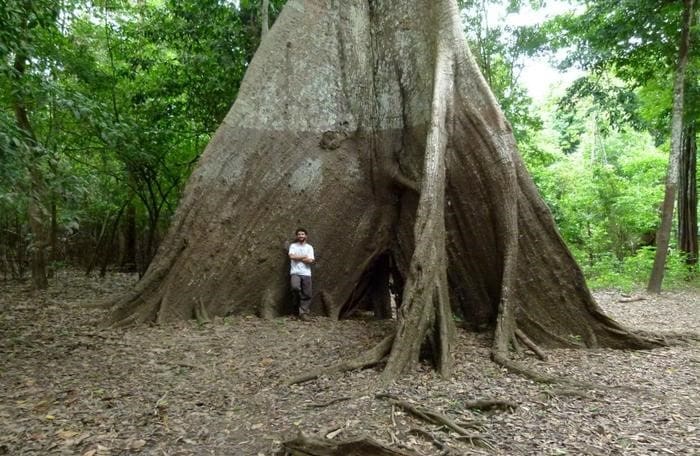Summary:
Rainfall in the Amazon is becoming more extreme, with increases during the wet season and declines during the dry season, according to new research published in Communications Earth & Environment.
By analyzing oxygen isotope ratios preserved in tree rings, an international team has reconstructed seasonal rainfall patterns in the region since 1980. Their analysis reveals that wet season rainfall has increased by 15–22%, while dry season rainfall has dropped by 5.8–13.5%. These opposing trends provide rare, independent evidence that the seasonality of the Amazon’s hydrological cycle is intensifying. The team used samples from both floodplain and non-flooded (terra firme) forests across two sites roughly 1,000 kilometers apart in western Amazonia.
Their findings suggest that changes in ocean temperatures and atmospheric circulation are influencing the Amazon’s climate, with both natural variability and human-driven warming playing a role. The study was led by scientists from the Universities of Leeds, Leicester, and the National Institute for Amazon Research in Brazil.
Researchers warn that increased seasonal extremes could fuel more frequent floods and droughts, affecting forest ecosystems, biodiversity, and the water and food security of riverine communities. As co-author Dr. Bruno Cintra notes, understanding these shifts is vital ahead of international climate negotiations at COP30 in Belém, Brazil.

Tree rings reveal increasing rainfall seasonality in the Amazon
Oxygen isotope signals in rings from two Amazon tree species allowed the international research team to reconstruct seasonal changes in rainfall for the recent past.
Publishing their findings in Communications Earth and Environment, the researchers reveal that wet season rainfall has increased by 15 – 22%, and dry season rainfall decreased by 5.8 – 13.5% since 1980.
The study is a result of a collaboration between the Universities of Leeds, Leicester and the National Institute for Amazon Research, in Brazil.

Co-author Dr. Bruno Cintra, now at the University of Birmingham, commented: “The Amazon is a key component of the Earth’s climate system. Understanding how its hydrological cycle is changing is essential for predicting future climate scenarios and developing effective conservation strategies. The upcoming COP30 in Belém, Brazil presents a critical opportunity for world leaders to take decisive action.”
Researchers believe this intensified seasonal cycle is caused by changes in temperatures of the surrounding Atlantic and Pacific oceans influencing the atmospheric circulation. While these changes are partly driven by natural variability, there are also strong indications that anthropogenic climate change plays a role.
Co-author Roel Brienen and Emanuel Gloor, from the University of Leeds, commented: “Our research demonstrates that the Amazon’s hydrological cycle is becoming more extreme. Increased wet season rainfall can lead to more frequent and severe flooding, while reduced dry season rainfall exacerbates drought conditions, impacting forest health and biodiversity.”
The study was based on oxygen isotope ratios from tree rings of Cedrela odorata and Macrolobium acaciifolium in the Amazon from 1980 to 2010 to reconstruct past wet and dry season rainfall variability. The researchers linked oxygen isotope changes to large-scale precipitation, estimating long-term rainfall changes and uncertainties using observed data, isotope models, and sensitivity analyses to atmospheric parameters.

Co-author Dr Arnoud Boom, from the University of Leicester, commented: “While traditional climate datasets may underestimate these changes, the tree ring isotope data offer a more integrated, large-scale perspective. Our unique approach combining oxygen isotope ratios in tree rings from non-flooded (terra firme) and from flooded Amazon forests allowed us to separately estimate wet and dry seasons rainfall trends.”
The Amazon rainforest plays a critical role in global climate regulation, acting as a major carbon sink and participating in global atmospheric patterns. Observed changes in the rainfall cycle could have far-reaching effects on global climate stability.
Co-author Dr Jochen Schöngart from the National Institute for Amazon Research (INPA) in Manaus, Brazil, commented: “These findings highlight that the Amazon is not simply drying or wetting overall but experiencing more extreme seasonal swings. This is of relevant concern as the intensification of the hydrological cycle impacts the functioning of ecosystems, water and food security of millions of traditional and indigenous people. Urgent actions to mitigate climate change and simultaneously adapt the livelihood and traditional management of the populations are required.”
Journal Reference:
Cintra, B.B.L., Gloor, E., Baker, J.C.A. et al., ‘Tree ring isotopes reveal an intensification of the hydrological cycle in the Amazon’, Communications Earth & Environment 6, 453 (2025). DOI: 10.1038/s43247-025-02408-9
Article Source:
Press Release/Material by University of Birmingham
Featured image credit: Bruno B.L. Cintra | University of Birmingham



